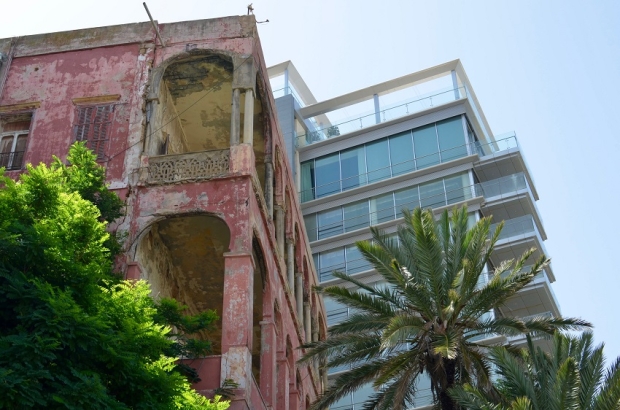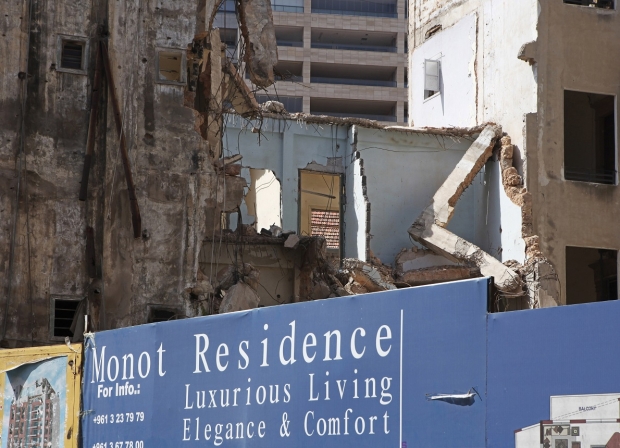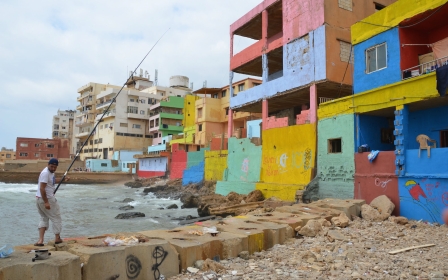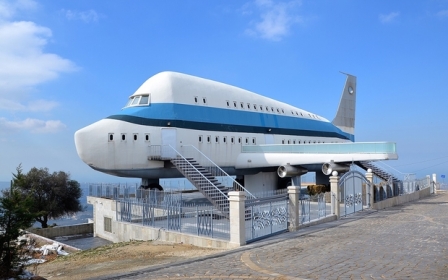Protecting Beirut's old buildings from the bulldozers
BEIRUT - In a yellow house pockmarked with bullet holes, high on Beirut's Achrafieh hill, a European delivers platitudes to a mostly Lebanese audience in an area that once housed a Roman necropolis.
“Every country needs to preserve its collective past,” says Philippe Lazzarini, UN deputy special coordinator for Lebanon, in order to avoid “collective amnesia”.
The occasion of Lazzarini’s speech this May was the opening of an exhibition of photographs sourced from Lebanese residents that for them encapsulate the civil war.
Many of the photos are of buildings shattered by the war, or left to decay while the fighting raged on.
Located in east Beirut’s Sodeco Square, in what was once the “Green Zone” – the demarcation line between the warring sides of the city during the civil war – Beit Beirut was previously known as the Barakat building, a striking neo-Ottoman apartment building constructed in two stages, completed respectively in 1924 and 1932. During the civil war, its occupants, middle-class families of different sects, moved out while Christian militia men moved in.
Bullet-riddled heritage
Looming above Beit Beirut is the nearly 200 metre-high sheath of Sama Beirut – the tallest tower in Lebanon, opened in 2017.
Having withstood 15 years of civil conflict and nearly two decades of rampant “reconstruction,” Beirut’s remaining heritage buildings linger: bullet-riddled stone facades crumbling and ancient wooden supports bleached to osteoporotic bones by the Mediterranean sun.
Other historic buildings have suffered a more ignominious fate - that of demolition and replacement by towering apartment blocks or temporary parking lots.
Lebanon has no legislation designed to incentivise the preservation of historic buildings, leaving cash-strapped owners few options but to sell, leave them to rot, or seek demolition permits.
Lebanon has no legislation designed to incentivise the preservation of historic buildings, leaving cash-strapped owners few options but to sell, leave them to rot, or seek demolition permits
According to Mona al-Hallak, an architect and activist who fought for years to preserve Beit Beirut, a 1995 study of Beirut’s heritage buildings found 1,052 structures worthy of protection. This was galvanised by the loss of downtown to the homogenous vision of former prime minister Rafik Hariri’s Solidere development company, which he founded in 1994.
In a revised study approved by the Directorate General of Urban Planning in 1997, Hallak says some 500 buildings were identified in four heritage “clusters”. Authorities watered down the findings, ignoring the clusters and categorising the structures according to their supposed architectural significance – rendering those in lower categories vulnerable to demolition.
Demolishing these protected buildings requires the approval of the culture minister, advised by a special committee, but the minister’s decision can be overruled by the State Shura Council, the highest administrative body in Lebanon.
Architects and activists who spoke with Middle East Eye said that close ties between Lebanon’s business and political communities, which facilitate the issuance of demolition permits and enforce the sacred status of private property, had ensured the ongoing destruction of Beirut’s old buildings.
Preserving memory
For two years, architect Maha Nasrallah has made sketches and watercolours of the abandoned buildings in her neighbourhood of Ras Beirut to ensure their memory is preserved, even if they are reduced to dust.
Her beautiful, vibrantly coloured sketches offer exquisite proof of the buildings’ wider meaning. Green bursts around most of the houses, signifying their attendant trees, and city life – dumpsters, cars, even the sea – swirl around them.
They are intimately connected to the place, even when they are almost hidden by encroaching development.
“I’m not against modern architecture at all,” Nasrallah says. “I am for beautiful new buildings too, but these buildings I’m talking about are characterless: they have absolutely no dialogue with the surroundings.”
I’m not against modern architecture … but these buildings I’m talking about are characterless: they have absolutely no dialogue with the surroundings
- Maha Nasrallah, architect
But the salvaging of such heritage is about more than just aesthetics. Mona Fawaz, an urban planning professor at the American University of Beirut, notes that the “main justification used in developed countries [for] public investments in heritage preservation is the maintenance of a collective identity, which coalesces around the common identification of a shared past, embodied in architecture”.
Joana Hammour, of the NGO Save Beirut Heritage, which campaigns for the protection of the city’s endangered buildings, bewails the “fatalistic” approach of the Lebanese but hopes a focus on heritage could strengthen the country’s sense of community.
“It’s not just about the aesthetics … there’s a social aspect about the quality of life. If you know your history, you respect more the value of where you’re living.” In Lebanon, she says, people “don’t feel connected. That’s why the heritage is important, because this is them – it’s their identity.”
“I don’t care about a single building,” she says. “It’s about a quality of life. It’s about a city that looked different. It didn’t look different because they had triple arches; it looked different because people were sitting on their balconies. It looked different because people had gardens whose doors were always open because there were trees.”
A draft law
In October 2017, the Cabinet approved a draft law to preserve Lebanon’s architectural heritage, forwarding it to parliament for discussion; but the law has yet to appear on the parliament’s agenda.
“It was completely out of the blue. We didn’t see that coming,” says Abdul-Halim Jabr, an architect and activist who helped draft the document.
The draft law, Jabr says, was finished in late 2015 and lays out “a very complex set of incentives and penalties”.
A lot of private owners are against this law in a very aggressive way
- Joana Hammour, Save Beirut's Heritage
It seeks to appeal to owners, developers and investors on the one hand, and activists, urban planners and architects on the other. Its pièce de résistance is a proposed mechanism allowing the transfer of development rights (TDR).
The TDR provision is designed to allow the owners of protected buildings to profit from their properties – and thus better maintain them – without knocking down or selling off the built heritage of the city.
It does so by allowing heritage property owners to sell “air rights” of the area they cannot use because of its protected status to developers. The purchaser then applies these building rights to a different building site to add to a development project in a neighbourhood deemed non-vulnerable.
The new law also incentivises owners to take the initiative to register their houses as heritage properties – affording them 100 percent of the TDR proceeds if they do so, rather than the 75 percent received if the state approaches them.
“A lot of private owners are against this law in a very aggressive way,” says Hammour.
The owners protested against the bill in March, requesting the government clarify its wording, include owners in the decision-making and take responsibility for preserving all heritage buildings.
Risky tool
The TDR mechanism has also attracted criticism from the opposite end of the spectrum.
“Evidence from cities around the globe, from India to the United States, has shown the tool to be risky, encourage speculative practices, and to actually exacerbate the real problem: the commodification of land,” says Fawaz.
Jabr acknowledges the potential misuse of the legislation. “Of course there’s a high degree of risk,” he says, “and in Lebanon, if anything can go wrong it probably will.” But he notes that the draft law, as it stands, takes measures to mitigate those risks.
I fear that the law is so complex and potentially lucrative, if taken in a certain direction, that it might be taken hostage
- Mona al-Hallak, architect
The clauses pertaining to the receiving end of the TDR are conservative, stipulating that developers can only apply “air rights” to a large construction site in an area with a lot of existing infrastructure. Moreover, they will only be able to increase the built area by a maximum of 20 percent.
“We were very cautious. It’s measured, it’s limited. We thought a lot about it, because we had 20 years to think about it,” Jabr says. Given Lebanon’s political and economic realities, this compromise, he says, is the best chance for the country’s remaining old buildings.
Hallak echoes these sentiments. “Without a law, we’re only buying time.”
Nevertheless, in trying to target the real estate sector, Jabr admits, with a wry laugh, “You’re really messing with the biggest money-making machine in Lebanon.”
“I fear that the law is so complex and potentially lucrative, if taken in a certain direction, that it might be taken hostage,” he adds, speculating that “a few privileged decision-makers can put the whole process to their liking,” bundling this legislation into “a whole basket of kickbacks, benefits, commissions".
And even if the law were to be passed in its current form, its implementation would require ongoing work by a severely understaffed public sector to deliver decrees on a case-by-case basis to shepherd through TDR transactions.
“People think if the law is passed, then it will be resolved,” Hallak says. “It’s the first step of a very long way.”
Tourism asset
The changing face of the city also has obvious financial repercussions – heritage preservation is often used as an economic development strategy, and could be a major boon to Lebanon’s tourism industry.
“You can start imagining the ... historical trails that can link the houses so people can walk through the city discovering it at different periods,” Nasrallah says. “It’s a different reading of the city every time.”
I hope someday politicians will really look at heritage not as a real estate investment
- Mona al-Hallak, architect
Hammour and Edouard Bitar of Live Love Beirut – an offshoot of Live Love Lebanon, an NGO that promotes the country’s positive image and has worked closely with the tourism ministry – suggest the ministry has little interest in capitalising on Beirut’s urban treasures.
In the last days of May, three more heritage buildings had their immunity revoked by the authorities, although outcry over the demolition prompted the Beirut governor to temporarily halt the work.
Just a short walk from Beit Beirut and the Sama spire, Jabr calls this cluster one of the city’s most coherent, as it is made up of three French Mandate-era buildings, with elements of traditional architecture.
Losing it, Jabr says, would “ruin” the entire western edge of the Achrafieh neighbourhood. He worries that, in its place, a tower to rival Sama could spring up.
But he and others haven’t yet lost hope that some of Beirut’s heritage architecture - and with it a memory of a shared identity and a collective, complex past - can be saved.
“I hope someday politicians will really look at heritage not as a real estate investment,” Hallak says. “I think it’s very difficult, but I decided to live in this country and not to leave. I will fight for every bit of it, because I hope my son will see it … If you give up, what happens? There’s no other way.”
New MEE newsletter: Jerusalem Dispatch
Sign up to get the latest insights and analysis on Israel-Palestine, alongside Turkey Unpacked and other MEE newsletters
Middle East Eye delivers independent and unrivalled coverage and analysis of the Middle East, North Africa and beyond. To learn more about republishing this content and the associated fees, please fill out this form. More about MEE can be found here.











